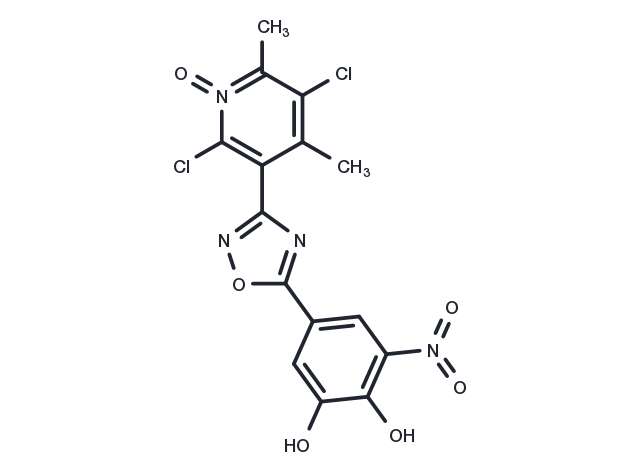Powder: -20°C for 3 years | In solvent: -80°C for 1 year


Opicapone (BIA 9-1067) reduces the ATP content of the cells (IC50: 98 μM). Opicapone is an effective third-generation catechol-O-methyltransferase inhibitor for the research of Parkinson's disease and motor fluctuations.

| Pack Size | Availability | Price/USD | Quantity |
|---|---|---|---|
| 1 mg | In stock | $ 59.00 | |
| 2 mg | In stock | $ 86.00 | |
| 5 mg | In stock | $ 143.00 | |
| 10 mg | In stock | $ 243.00 | |
| 25 mg | In stock | $ 446.00 | |
| 50 mg | In stock | $ 658.00 | |
| 100 mg | In stock | $ 938.00 | |
| 1 mL * 10 mM (in DMSO) | In stock | $ 159.00 |



| Description | Opicapone (BIA 9-1067) reduces the ATP content of the cells (IC50: 98 μM). Opicapone is an effective third-generation catechol-O-methyltransferase inhibitor for the research of Parkinson's disease and motor fluctuations. |
| In vitro | Opicapone decreases the mitochondrial membrane potential of the cells (IC50: 181 μM). Opicapone has a prolonged inhibitory effect on peripheral COMT, which extends the bioavailability of L-DOPA, without inducing toxicity. Incubation of human primary hepatocytes for 24 h with increasing concentrations of Ro 40-7592, OR-611 or Opicapone resulted in a concentration-dependent decrease in the mitochondrial membrane potential of the cells, evaluated by the ratio JC-1 aggregates over JC-1 monomer (ratio λex 544 λem 590 over λex 485 λem 538) [1]. |
| In vivo | Opicapone inhibited rat peripheral COMT with ED50 values below 1.4 mg kg(-1) up to 6 h post-administration.?The effect was sustained over the first 8 h and by 24 h COMT had not returned to control values.?A single administration of opicapone resulted in increased and sustained plasma levodopa levels with a concomitant reduction in 3-O-methyldopa from 2 h up to 24 h post-administration, while tolcapone produced significant effects only at 2 h post-administration.?The effects of opicapone on brain catecholamines after levodopa administration were sustained up to 24 h post-administration.?Opicapone was also the least potent compound in decreasing both the mitochondrial membrane potential and the ATP content in human primary hepatocytes after a 24 h incubation period[1]. |
| Synonyms | BIA 9-1067 |
| Molecular Weight | 413.17 |
| Formula | C15H10Cl2N4O6 |
| CAS No. | 923287-50-7 |
Powder: -20°C for 3 years | In solvent: -80°C for 1 year
DMSO: 100 mg/mL (242.03 mM), Sonication is recommended.
You can also refer to dose conversion for different animals. More
bottom
Please see Inhibitor Handling Instructions for more frequently ask questions. Topics include: how to prepare stock solutions, how to store products, and cautions on cell-based assays & animal experiments, etc.
Opicapone 923287-50-7 Metabolism Transferase BIA 9-1067 Inhibitor inhibit COMT inhibitor
